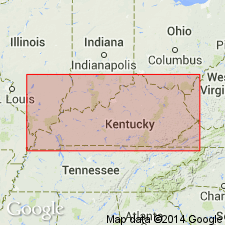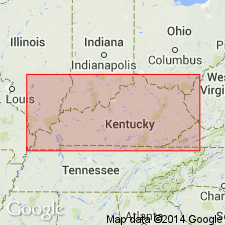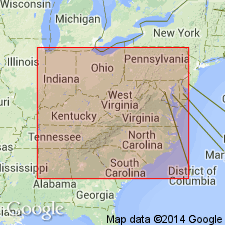
- Usage in publication:
-
- Dave Branch shale member
- Modifications:
-
- Informally named
- Dominant lithology:
-
- Shale
- AAPG geologic province:
-
- Appalachian basin
Summary:
Breathitt Formation is informally elevated to group rank and subdivided into the following eight informal formations: Pocahontas, Bottom Creek, Alvy Creek, Grundy, Pikeville, Hyden, Four Corners, and Princess formations. Dave Branch shale member is here informally named and assigned to the Grundy formation in Whitley Co., KY. At the type section, the Dave Branch consists of 30 to 36 ft of silty, dark-gray, carbonaceous and fissile shale with scattered siderite nodules. Contains ORBICULOIDEA, LINGULA, conodonts. Basal bed is thin siderite layer. Overlies the informal Pine Creek sandstone beds of the Bee Rock Sandstone Member of the Lee Formation and disconformably underlies the informal Laurel River Dam sandstone beds. [Revisions made in this paper are strongly contested by C. Rice and other USGS scientists who work in this area (oral commun., 9/3/93).]
Source: GNU records (USGS DDS-6; Reston GNULEX).

- Usage in publication:
-
- Dave Branch shale member
- Modifications:
-
- Not used
- AAPG geologic province:
-
- Appalachian basin
Summary:
Grundy Formation of Breathitt Group is formally named in this report. Dave Branch shale member is shown in fig. 5, but is not mentioned in the text nor shown in any other figure or on any plate.
Source: GNU records (USGS DDS-6; Reston GNULEX).

- Usage in publication:
-
- Dave Branch shale member
- Modifications:
-
- Areal extent
- AAPG geologic province:
-
- Appalachian basin
Summary:
Corr. chart. Dave Branch shale member (informal) of Grundy Formation of Breathitt Group. Shale and/or mudstone. Recognized in eastern and southeastern Kentucky in lower part of Grundy Formation, beneath the informal Molus shale member. In eastern Kentucky overlies the Upper Banner coal bed; locally [Licking River and Southwestern districts] underlies Hazel Patch sandstone (informal, unranked). In southeastern Kentucky [Upper Cumberland River district] overlies Clear Fork (Rex) coal bed. Age is Early Pennsylvanian (Westphalian; Morrowan). [Greb and others (2009, Kentucky Geol. Survey, Spec. Pub. no. 10, ser. XII, p. 38-40) placed the Upper Banner coal bed (of Norton Formation in Virginia) in upper part of Westphalian A, RADIIZONATES ALIGERENS (RA) miospore assemblage zone of western Europe.]
[See also Chesnut, 1997 (revised Oct. 12, 1999), Stratigraphy of the coal-bearing strata of the Eastern Kentucky coal field, available online through the Kentucky Geol. Survey (http://www.uky.edu/KGS/coal/coalcorrel.htm).]
Source: Publication.
For more information, please contact Nancy Stamm, Geologic Names Committee Secretary.
Asterisk (*) indicates published by U.S. Geological Survey authors.
"No current usage" (†) implies that a name has been abandoned or has fallen into disuse. Former usage and, if known, replacement name given in parentheses ( ).
Slash (/) indicates name conflicts with nomenclatural guidelines (CSN, 1933; ACSN, 1961, 1970; NACSN, 1983, 2005, 2021). May be explained within brackets ([ ]).

